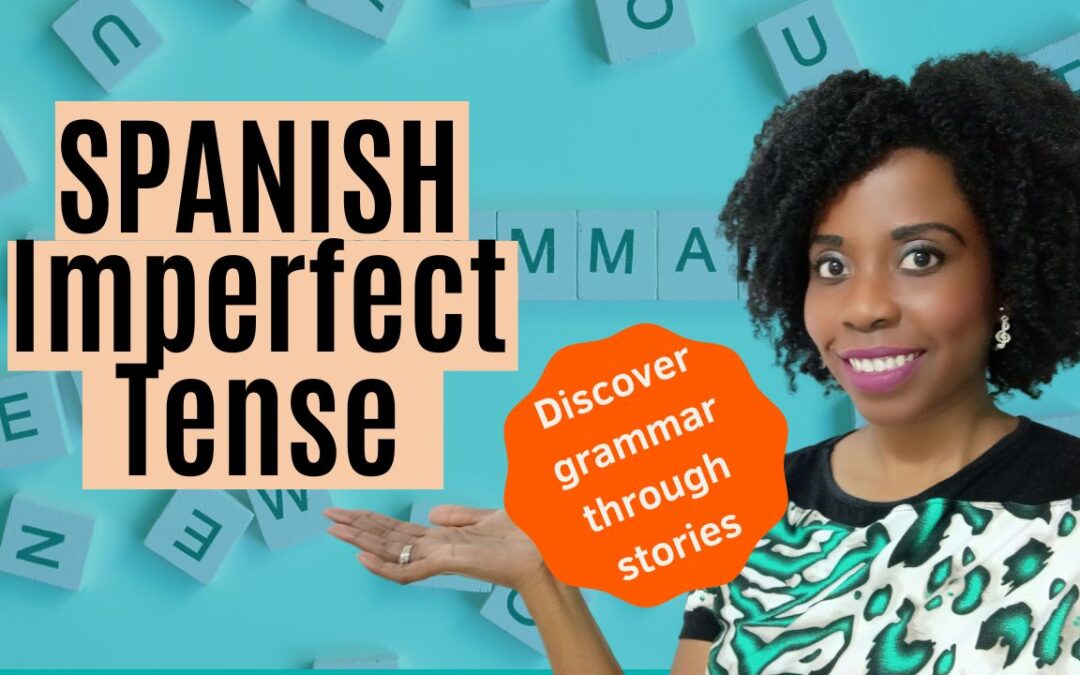Imagine you’re telling a story in Spanish about your childhood—describing what life was like, the things you used to do, the games you played, and how you felt. Or maybe you want to paint a picture of a place you visited, explaining how the weather was, what people were doing, and the atmosphere around you.
To express all of this naturally, you need the Spanish imperfect tense.
This is actually my favorite verb tense! Why? Because it plays a crucial role in storytelling, helping us share rich details and emotions. (And I love stories!)
Because it plays a crucial role in storytelling, helping us share rich details and emotions. (And I love stories!) Because it’s one of the easiest tenses to learn! (You’ll see why in a moment!)
Because it’s one of the easiest tenses to learn! (You’ll see why in a moment!)
For a full breakdown, check out my YouTube lesson here, based on one of the original Spanish stories on the channel!
What Is the Imperfect Tense?
The imperfect tense is one of two main past tenses in Spanish (imperfect vs. preterite). But what makes it different from the preterite (hablé, comí, viví)?
Use the imperfect when describing:
- Habitual or repeated past actions (used to / would do)
- Ongoing past actions (was/were -ing)
- Descriptions or setting the scene (background details)
Key point: The imperfect does not focus on a specific start or end time—it just describes what things were like in the past.
Use #1: Habitual or Repeated Actions
Use the imperfect when talking about things that happened regularly in the past, without a defined beginning or end.
Examples:
- Cuando era niño, jugaba en el parque todos los días.
(When I was a child, I used to play in the park every day.) - Mi abuela siempre cocinaba los domingos.
(My grandmother always cooked on Sundays.) - Íbamos a la playa cada verano.
(We used to go to the beach every summer.)
A few examples of key words that often trigger the imperfect:
Siempre (always), todos los días (every day), cada verano (every summer), por lo general (generally), a menudo (often).
Use #2: Ongoing Actions in the Past
Use the imperfect when an action was in progress at some point in the past.
Examples:
- Ella estaba leyendo un libro cuando llamaste.
(She was reading a book when you called.) - Llovía mucho aquella tarde.
(It was raining a lot that afternoon.) - Mientras cenábamos, sonó el teléfono.
(While we were having dinner, the phone rang.)
 Compare with the Preterite:
Compare with the Preterite:
- Llovía mucho aquella tarde. (It was raining…) → Imperfect (background action)
- Llovió mucho ayer. (It rained a lot yesterday.) → Preterite (completed action)
Use #3: Descriptions & Setting the Scene
The imperfect is often used for background descriptions—of people, places, weather, time, emotions, etc.
Examples:
- Hacía mucho calor y el sol brillaba.
(It was very hot, and the sun was shining.) - La casa era grande y tenía muchas ventanas.
(The house was big and had many windows.) - Ella estaba feliz porque tenía un perrito nuevo.
(She was happy because she had a new puppy.)
How to Form the Imperfect Tense
Good news! The imperfect is one of the easiest tenses to conjugate because it follows predictable patterns. Plus, there are only three irregular verbs! (That’s why it’s my favorite!)
For -AR Verbs (like hablar)
- Yo: hablaba
- Tú: hablabas
- Él/Ella/Ud.: hablaba
- Nosotros: hablábamos
- Ellos/Ellas/Uds.: hablaban
For -ER Verbs (like comer)
- Yo: comía
- Tú: comías
- Él/Ella/Ud.: comía
- Nosotros: comíamos
- Ellos/Ellas/Uds.: comían
For -IR Verbs (like vivir)
- Yo: vivía
- Tú: vivías
- Él/Ella/Ud.: vivía
- Nosotros: vivíamos
- Ellos/Ellas/Uds.: vivían
Notice:
- All -ER and -IR verbs share the same endings (-ía, -ías, -ía, -íamos, -ían).
- Only -AR verbs have a unique pattern (-aba, -abas, -aba, -ábamos, -aban).
Irregular Verbs? Just Three!
There are only three irregular verbs in the imperfect:
Ser (to be)
- Yo: era
- Tú: eras
- Él/Ella/Ud.: era
- Nosotros: éramos
- Ellos/Ellas/Uds.: eran
Ir (to go)
- Yo: iba
- Tú: ibas
- Él/Ella/Ud.: iba
- Nosotros: íbamos
- Ellos/Ellas/Uds.: iban
Ver (to see/watch)
- Yo: veía
- Tú: veías
- Él/Ella/Ud.: veía
- Nosotros: veíamos
- Ellos/Ellas/Uds.: veían
That’s it! Every other verb follows the regular pattern.
Practice Time!
Choose the correct form of the imperfect tense for each sentence. The answers are in the P.S.—but no peeking until you’re done! 
 Cuando yo ___ (ser/irregular) niño, me encantaba jugar con mis amigos.
Cuando yo ___ (ser/irregular) niño, me encantaba jugar con mis amigos.
(When I was a child, I loved playing with my friends.)
 Mientras ella ___ (cocinar/regular) la cena, su esposo veía la televisión.
Mientras ella ___ (cocinar/regular) la cena, su esposo veía la televisión.
(While she was cooking dinner, her husband was watching TV.)
 Siempre ___ (ir/irregular) a la casa de mis abuelos los domingos.
Siempre ___ (ir/irregular) a la casa de mis abuelos los domingos.
(We always went to my grandparents’ house on Sundays.)
 Mi hermana ___ (ver/irregular) dibujos animados todas las mañanas.
Mi hermana ___ (ver/irregular) dibujos animados todas las mañanas.
(My sister used to watch cartoons every morning.)
 El parque ___ (estar/regular) lleno de niños jugando.
El parque ___ (estar/regular) lleno de niños jugando.
(The park was full of children playing.)
 Mis amigos y yo ___ (vivir/regular) en una ciudad pequeña cuando éramos jóvenes.
Mis amigos y yo ___ (vivir/regular) en una ciudad pequeña cuando éramos jóvenes.
(My friends and I lived in a small town when we were young.)
 La maestra siempre ___ (explicar/regular) la lección con paciencia.
La maestra siempre ___ (explicar/regular) la lección con paciencia.
(The teacher always explained the lesson patiently.)
 Nosotros ___ (tener/regular) un perro cuando éramos pequeños.
Nosotros ___ (tener/regular) un perro cuando éramos pequeños.
(We had a dog when we were little.)
 Cuando hacía frío, mi abuela siempre ___ (preparar/regular) chocolate caliente.
Cuando hacía frío, mi abuela siempre ___ (preparar/regular) chocolate caliente.
(When it was cold, my grandmother always made hot chocolate.)
 Antes, tú ___ (ser/irregular) más tímido en la escuela.
Antes, tú ___ (ser/irregular) más tímido en la escuela.
(Before, you used to be shyer in school.)
Your Challenge
This week, carve out a few minutes to watch my YouTube lesson here for a more detailed explanation about the imperfect tense and fun practice with a story! Be sure to complete all the exercises as you go along!
Hasta la próxima,
Erica
P.S. Answers to the Practice Section:
 era (ser – describing past childhood)
era (ser – describing past childhood) cocinaba (cocinar – past ongoing action)
cocinaba (cocinar – past ongoing action) íbamos (ir – habitual past action)
íbamos (ir – habitual past action) veía (ver – repeated past action)
veía (ver – repeated past action) estaba (estar – setting the scene)
estaba (estar – setting the scene) vivíamos (vivir – describing past living situation)
vivíamos (vivir – describing past living situation) explicaba (explicar – habitual past action)
explicaba (explicar – habitual past action) teníamos (tener – past possession/habit)
teníamos (tener – past possession/habit) preparaba (preparar – routine past action)
preparaba (preparar – routine past action) eras (ser – past description of personality)
eras (ser – past description of personality)
Erica Ray
Latest posts by Erica Ray (see all)
- The Spanish Imperfect Tense (essential for good storytelling!) - February 10, 2025
- Real Spanish Conversation: El Trabajo (Spanish Listening Practice for Intermediate/Advanced) - January 14, 2025
- Por vs Para: The SIMPLEST way to understand and choose between them - January 14, 2025

